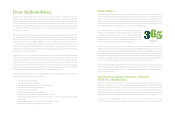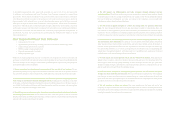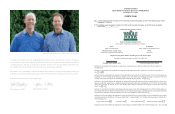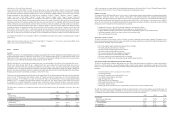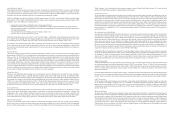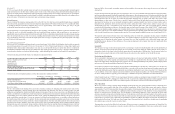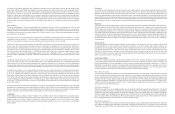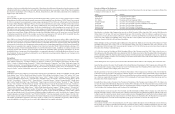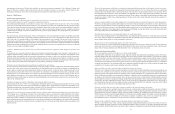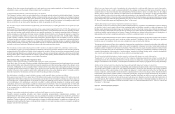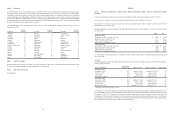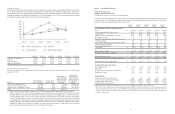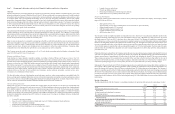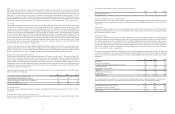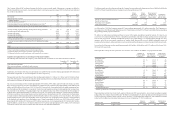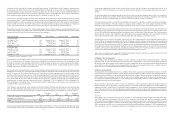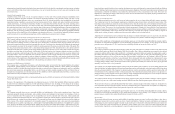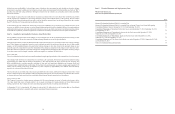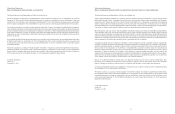Whole Foods 2015 Annual Report Download - page 13
Download and view the complete annual report
Please find page 13 of the 2015 Whole Foods annual report below. You can navigate through the pages in the report by either clicking on the pages listed below, or by using the keyword search tool below to find specific information within the annual report.13
offerings, if new laws require the reformulation of certain products to meet tougher standards, or if natural disasters or other
catastrophic events occur, the supply of these products may be constrained.
A widespread health epidemic could materially impact our business.
The Company’s business could be severely impacted by a widespread regional, national or global health epidemic. Our stores
are a place where customers come together, interact and learn and at the same time discover the many joys of eating and sharing
food. A widespread health epidemic may cause customers to avoid public gathering places or otherwise change their shopping
behaviors. Additionally, a widespread health epidemic could also adversely impact our business by disrupting production and
delivery of products to our stores and by impacting our ability to appropriately staff our stores.
Our stock price may be volatile and adversely affected by general market factors, including fluctuations in our quarterly results
of operations.
In fiscal year 2015, the closing market price per share of our common stock ranged from $31.10 to $57.20. The market price of
our common stock could be subject to significant fluctuation in response to various market factors and events, including variations
in our sales and earnings results and any failure to meet market expectations. Our quarterly operating results and quarter-to-
quarter comparisons could fluctuate for many reasons, including, but not limited to, price changes in response to competitive
factors, seasonality, holiday shifts, increases in store operating costs, including commodity costs, possible supply shortages,
general economic conditions, extreme weather-related disruptions, and other business costs. In addition, we may be impacted
by changes in ratings and earnings estimates by securities analysts; publicity regarding us, our competitors, or the natural products
industry generally; new statutes or regulations or changes in the interpretation of existing statutes or regulations affecting the
natural products industry specifically; sales of substantial amounts of common stock in the public market or the perception that
such sales could occur; broad price fluctuations in the overall stock market and other factors.
Our investments in money market funds and certain other securities are subject to market risks, which may result in losses.
As of September 27, 2015, we had approximately $32 million in short-term investments classified as cash and cash equivalents
and approximately $218 million in available-for-sale marketable securities. We have invested these amounts primarily in state
and local municipal obligations, government agency securities, corporate commercial paper and bonds, and money market funds
meeting certain criteria. These investments are subject to general credit, liquidity, market and interest rate risks, which, if they
materialize, could have a negative impact on our results of operations.
Financial Reporting, Legal and Other Regulatory Risks
Pending or future legal proceedings could materially impact our results of operations.
From time to time, we are party to legal proceedings, including matters involving personnel and employment issues, personal
injury, product liability, protecting our intellectual property, acquisitions, and other proceedings arising in the ordinary course
of business. Additionally, we are occasionally subject to industry-wide or class-action claims arising from the products we carry
or industry-specific business practices. Further, we are involved in several securities class action litigation matters. Additional
volatility in the price of our securities could result in additional securities class action litigation matters. Our results could be
materially impacted by the decisions and expenses related to pending or future proceedings.
Our indebtedness or inability to comply with debt covenants could materially impact our future cash flows.
Subsequent to fiscal year 2015, we entered into a $500 million revolving line of credit that extends to 2020, and we may incur
additional debt in the future. Changes in our credit ratings, or in the interest rate environment, could have an adverse impact on
our financing costs. A significant portion of our future cash flow from operating activities may be dedicated to the repayment
of our indebtedness. Our indebtedness could limit our ability to obtain additional financing for working capital, capital
expenditures, debt service requirements, acquisitions or other purposes in the future. There is no guarantee that we will be able
to meet our debt service obligations. If we fail to comply with our debt covenants, we will be in default, in which case there can
be no assurance that we would be able to cure the default, receive waivers from our lenders, amend the loan agreement or
refinance the debt.
Changes in accounting standards and estimates could materially impact our results of operations.
Generally accepted accounting principles and related accounting pronouncements, implementation guidelines, and
interpretations for many aspects of our business, such as accounting for insurance and self-insurance, inventories, goodwill and
intangible assets, store closures, leases, income taxes and share-based payments, are highly complex and involve subjective
judgments. Changes in these rules or their interpretation or changes in underlying estimates, assumptions or judgments by our
management could significantly change or add significant volatility to our reported earnings without a comparable underlying
change in cash flow from operations.
14
Effective tax rate changes and results of examinations by taxing authorities could materially impact our results of operations.
Our future effective tax rates could be adversely affected by the earnings mix being lower than historical results in states or
countries where we have lower statutory rates and higher-than-historical results in states or countries where we have higher
statutory rates, by changes in the valuation of our deferred tax assets and liabilities, or by changes in tax laws or interpretations
thereof. In addition, we are subject to periodic audits and examinations by the Internal Revenue Service (“IRS”) and other state
and local taxing authorities. Our results could be materially impacted by the determinations and expenses related to proceedings
by the IRS and other state and local taxing authorities. See Note 10 of the Notes to Consolidated Financial Statements in Part
II, “Item 8. Financial Statements and Supplementary Data,” of this report.
Unfavorable changes in governmental regulation could harm our business.
The Company is subject to various local, state, federal and international laws, regulations and administrative practices affecting
our business, and we must comply with provisions regulating health and sanitation standards, weights and measures, food
labeling, equal employment, minimum wages, and licensing for the sale of food and, in some stores, alcoholic beverages. Our
new store openings could be delayed or prevented or our existing stores could be impacted by difficulties or failures in our ability
to obtain or maintain required approvals or licenses. Changes in existing laws, changes in the enforcement of existing laws, or
implementation of new laws, regulations and practices could have a significant impact on our business.
The USDA’s Organic Rule facilitates interstate commerce and the marketing of organically produced food, and provides assurance
to our customers that such products meet consistent, uniform standards. Compliance with this rule could pose a significant
burden on some of our suppliers, which may cause a disruption in some of our product offerings.
We cannot predict the nature of future laws, regulations, interpretations or applications, or determine what effect either additional
government regulations or administrative orders, when and if promulgated, or disparate local, state, federal and international
regulatory schemes would have on our business in the future. They could, however, require the reformulation of certain products
to meet new standards, the recall or discontinuance of certain products not able to be reformulated, additional recordkeeping,
expanded documentation of the properties of certain products, expanded or different labeling and/or scientific substantiation.
Any or all of such requirements could have an adverse effect on our operating results.
The risk associated with doing business in other countries could materially impact our results of operations.
Though only 3.1% of our total sales in fiscal year 2015, the Company’s international operations are subject to certain risks of
conducting business abroad, including fluctuations in foreign currency exchange rates, changes in regulatory requirements, and
changes or uncertainties in the economic, social and political conditions in the Company’s geographic areas, among other things.
A failure of our internal control over financial reporting could materially impact our business or stock price.
The Company’s management is responsible for establishing and maintaining adequate internal control over financial reporting.
An internal control system, no matter how well designed and operated, can provide only reasonable, not absolute, assurance
that the objectives of the control system are met. Further, the design of a control system must reflect the fact that there are
resource constraints, and the benefits of controls must be considered relative to their costs. Because of the inherent limitations
in all internal control systems, internal control over financial reporting may not prevent or detect misstatements. Any failure to
maintain an effective system of internal control over financial reporting could limit our ability to report our financial results
accurately and timely or to detect and prevent fraud, and could expose us to litigation or adversely affect the market price of
our common stock. The Company’s management concluded that its internal control over financial reporting was effective as of
September 27, 2015. See Management’s Report on Internal Control over Financial Reporting in Part II, “Item 9A. Controls and
Procedures,” of this report.
Item 1B. Unresolved Staff Comments.
Not applicable.


